This document covers the following topics:
 To list all functions available for a Symbol Table Master
node
To list all functions available for a Symbol Table Master
node
In the object workspace, select the Symbol Table Master metanode from an Owner instance and open the context menu.
The following functions are available:
| Function | Shortcut | Description |
|---|---|---|
| List | F8 | See Listing Objects. |
| New | CTRL+N | See Adding a Symbol Table Master. |
| Refresh | F5 | See Refreshing Object Lists. |
| Filter | F3 | See Filtering Objects. |
| Paste data | CTRL+V | See Pasting Objects. |
| Export | --- | See Exporting Objects in the Import/Export Functions documentation. |
| Set Drag And Drop Function | --- | See Drag & Drop. |
 To list all functions available for a symbol table master
To list all functions available for a symbol table master
From the Symbol Table Master node, select an instance and open the context menu.
The following functions are available:
| Function | Shortcut | Description |
|---|---|---|
| Open | CTRL+O | See Modifying a Symbol Table Master. |
| Display | CTRL+D | See Displaying a Symbol Table Master. |
| Where used | --- | See Listing Jobs and Networks that Use a Symbol Table Master. |
| Delete | DELETE | See Deleting a Symbol Table Master. |
| Copy data | CTRL+C | See Copying Objects. |
| Version Usage | --- | See Maintaining the Usage of Symbol Table Versions. |
| Export | --- | See Exporting Objects in the Import/Export Functions documentation. |
| Add to Workplan | --- | See Add to Workplan. |
| Save as File | --- | See Saving Symbol Tables as Files. |
| Set Drag And Drop Function | --- | See Drag & Drop. |
 To list all master symbol tables of an owner
To list all master symbol tables of an owner
In the object workspace, select the Symbol Table Master node of an owner and choose from the context menu, or press F8.
A Symbol Table Master List window similar to the example below opens:
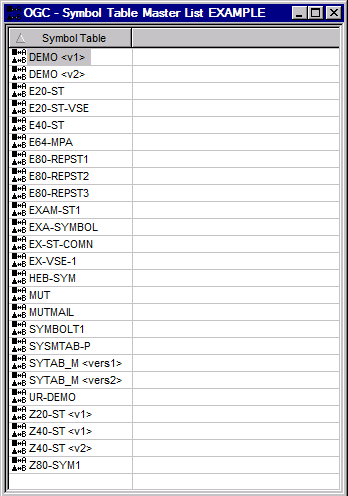
This window lists master symbol tables already defined to
Entire Operations. You see only the symbol tables that belong to your owner
(here: EXAMPLE). If no master symbol tables have been defined for
your owner, the list is empty.
The functions available from the context menu are explained in Available Functions: Symbol Table Master List.
This section covers the following:
When you select a symbol table from the Symbol Table Master List window, you can open a context menu and perform the following functions:
| Function | Shortcut | Description |
|---|---|---|
| Open | CTRL+O | See Modifying a Symbol Table Master. |
| Display | CTRL+D | See Displaying a Symbol Table Master. |
| New | CTRL+N | See Adding a Symbol Table Master. |
| Refresh | F5 | See Refreshing Object Lists. |
| Where used | --- | See Listing Jobs and Networks that Use a Symbol Table Master. |
| Delete | DELETE | See Deleting a Symbol Table Master. |
| Copy data | CTRL+C | See Copying Objects - Copy Data Function. |
| Paste data | CTRL+V | See Pasting Objects. |
| Version Usage | --- | See Maintaining the Usage of Symbol Table Versions. |
| Export | --- | See Exporting Objects in the Import/Export Functions documentation. |
| Add to Workplan | --- | See Add to Workplan. |
| Save as File | --- | See Saving Symbol Tables as Files. |
This section describes how to maintain and use different versions of symbol tables.
The following applies when creating version names:
The name can contain up to 10 alphanumeric characters and uppercase or lowercase letters.
Space characters and the following special characters are not allowed:
?<>*‚()_
In general, do not use special characters and umlauts to avoid problems when porting an Entire Operations environment to another platform.
Do not use a reserved version name (see the following section).
With the usage of a global version names exit you can force a user-specific version name syntax. For detailed information, see Global Exit for Version Names in the Administration documentation.
- blank value; in selections and in the log also:
(unnamed)Is used for an unnamed version.
This is the only network version that exists after migration from an earlier Entire Operations version that does not support network versioning.
In parameter listings (e.g., for reporting) you can use also a hyphen (
-).(current)Will be replaced by the version that is set in the activated time schedule.
(current)can be used in version references.(nv)Will be replaced by the network version of the active network. If only an unnamed network version exists, then this symbol table will be referred to this.
If a symbol table version with the same name is not existent in the network version, then an error message will be sent and the request aborted.
(svn)The symbol table version will be replaced thru the active network.
(svn)can be used in referenced versions of a slaved network.Example of use:
Job definition
(svj)The symbol table version will be replaced thru the active job.
(svj)can be used in referenced versions of a slaved job.Examples of use:
Requested prerequisite dependent on the symbol value,
Requested prerequisite dependent on multiple-value symbols,
End-of-Job action: set symbol.
You can copy symbol tables to add a new version for an existing symbol table. This is a common way to build new symbol table versions.
Symbols in any version can copied out of the originating symbol table.
If multiple versions of a symbol table exist, then one must select one to be deleted.
A symbol table version cannot be deleted if listed in an activated time schedule as a standard version. A defined date in the past is not relevant.
By using the API NOPUSY7N you can delete single symbol table versions and symbols.
To maintain version usage in symbol table administration, use the functions described in Maintaining the Usage of Symbol Table Versions.
Symbol table versions can be defined in the following:
Network versions definition,
Job definition.
The activation of symbol tables is a component of network and job activations.
A symbol table can only be activated in a clearly identified version. The identification of the requested symbol table version is part of the activation process.
Active symbol tables loose there version nomenclature
(current) or (nv). They are detached during
activation.
Active symbol tables can only have the version nomenclature
(none) or a defined version name.
If a requested symbol table version is missing, or the version cannot be defined, then the activation process will be aborted with an error message.
Before symbol prompting (during manual activation and before executing the symbol prompting exit in the Monitor), the symbol table versions to be used will be clearly determined. See also Symbol Prompting during Network or Job Activation.
If at least one symbol table version cannot be identified, the activation process will be aborted with an error message.
The order in which symbols are searched for in the symbol tables defined in your environment depends on the hierarchy levels at which the symbol tables defined in you environment can be accessed: see Symbol Table Types and Symbol Search Order.
Global symbol tables are not version-controlled.
The symbol tables are:
SYSDBA / A owner / A
Logging of symbol actions include the version of the table where the symbol was loaded from.
The generated comments in the Entire Operations JCL header contain the symbol table version of all used symbols.
Symbol table versions will be considered.
Symbol table versions will be considered.
Symbol table versions will be considered.
Entire Operations provides user exits and APIs that are related to
symbols and support network versioning, for example, API
NOPUSY7N.
The maximum number of symbol table versions can be limited system wide as described in Defaults for Network Options in the Administration documentation.
 To display a symbol table master
To display a symbol table master
In the object workspace, select a Symbol Table Master instance.
Choose Display from the context menu, or
press CTRL+D.
A Display Symbol Table Master window similar to the Maintenance Symbol Table Master window opens.
The window contains a table with a list of all symbols defined for the symbol table master.
The fields and table columns contained in the window are explained in Fields and Columns: Symbol Table Master.
If you want to view additional information on a listed symbol, select the required symbol from the table and choose .
A Display Symbol Master window similar to the Maintenance Symbol Master window opens.
You can view all symbol definitions on the tabbed pages of the window. The fields on the pages are described in Fields: Master and Active Symbols.
You can add a symbol table master by either copying an existing table (see the Copy data/Paste data functions of a symbol table instance/master node) or creating a new symbol table with the New function. This requires that you define at least one symbol master along with the table.
This section provides instructions for using the New function.
 To add a symbol table master
To add a symbol table master
In the object workspace, select the Symbol Table Master metanode.
From the context menu choose , or press CTRL+N.
A Create new Symbol Table Master window opens.
The fields and columns contained in the window correspond to the field and columns in the Maintenance Symbol Table Master window. They are explained in Fields and Columns: Symbol Table Master.
Enter a name for the symbol table and symbol table version and choose .
A Create new Symbol Master window opens.
The fields and tabbed pages contained in the window correspond to the fields and tabbed pages in the Maintenance Symbol Master window. They are explained in Fields: Master and Active Symbols.
If required, enter a different symbol table name and version and make your definitions on the tabbed pages Main, Multiple Symbol Values and Value Check.
Choose OK when you are finished.
The symbol table master is created and now ready to use in the active network.
This section covers the following topics:
The fields on the tabbed pages Main, Multiple Symbol Values and Value Check (symbol masters only) of a Symbol Master or Symbol Active window are explained in the following table.
The fields are either write-protected or available for input depending on whether you view or modify the symbols. The table indicates when a field does not apply to active symbols.
| Main Page: | |||
|---|---|---|---|
| Symbol | Name of the symbol. | ||
| Format | Format of the symbol (variable). Possible values: | ||
| A | Alphanumeric (including special characters). | ||
| D | Date in the format YYYYMMDD (see also Date and Time Formats). | ||
| H | Alphanumeric; hidden.
|
||
| L | Alphanumeric; lower case. | ||
| N | Numeric.
See Value for the numeric field format. |
||
| U | Alphanumeric; upper case. | ||
| Value | Value of the symbol to be
substituted.
To enter a fixed length or an empty string, include the value in quotes. Use two apostrophes to get a quote within a string. Example: Notes:
See also Defining Multiple Symbol Values. |
||
| Prompting
(list box) |
Specifies whether the
user is to be prompted for this symbol during manual activation of the job
network. See also Symbol Prompting during
Network or Job Activation.
Possible selection options: |
||
| A | Prompt for symbol during each activation. | ||
| E | Prompt only if no value is specified in the table. | ||
| N | Never prompt for symbol. | ||
| Prompting
(check box) |
Write back modified
active symbol to the master table as well.
Note: |
||
| Prompt Text | Optional text to be displayed when symbol prompting is performed, to help the user specify the correct value. | ||
| Multiple Symbol Values Page: | |||
| Values 1 to 150 | Assign multiple values
to a symbol.
These can be used in subsequent replacements of the same symbol. See also Defining Multiple Symbol Values. You can enter up to 150 values here. The maximum value length is 120. These values are used for subsequent substitutions. |
||
| Value Check Page: | |||
| Not applicable to active
symbols.
Used to define a number range for numeric symbol values to be checked for valid input. See also Specifying a Range Check for Numeric Symbol Values. |
|||
| None | Select this button (default) if you neither use Range check nor User exit. | ||
| Select this button if you want to define and/or activate a range of numbers to be checked during input of numeric symbol values. | |||
| Value from | Start
number (Value from) and end number (Value
from) of the range to be checked.
Valid input values are positive integer numbers in the
range from |
||
| Value to | |||
| User exit | Select this button if you want to specify and/or activate a user exit. | ||
| Library | Name of the library that
contains the user exit.
Note: |
||
| User Exit | Name of the user exit.
If the name entered in Library is valid, you can select a user exit from the drop-down list box. If the specified exit does not (yet) exist, you will be warned with an appropriate message. |
||
Modifying a master symbol table or an active symbol table consists of adding, modifying or deleting symbols and their current values.
 To modify a symbol table master
To modify a symbol table master
In the object workspace, select a Symbol Table Master instance.
Invoke the context menu and choose the function.
Or:
Press CTRL+O.
A Maintenance Symbol Table Master window similar to the example below opens:
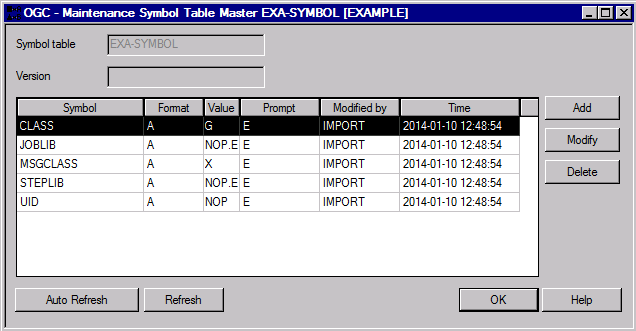
You can modify a selected symbol (here: CLASS) by
choosing , add a new symbol by choosing
, or delete a selected symbol by choosing
.
The fields and columns contained in the window are explained in Fields and Columns: Symbol Table Master.
If you choose Delete, a window prompts you to delete the selected symbol.
If you choose Modify or Add, a Maintenance Symbol Master window similar to the example below opens:
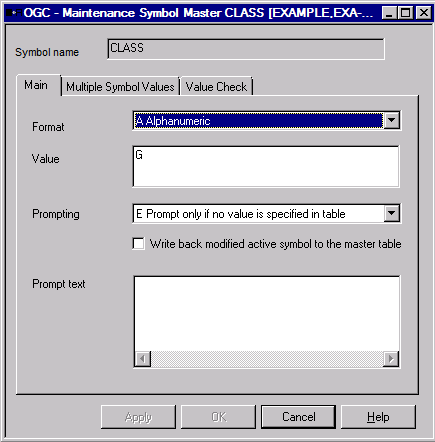
Make the required definitions in the fields of the tabbed pages Main, Multiple Symbol Values and Value Check. They are explained in Fields: Master and Active Symbols.
Choose when you are finished.
The symbol table master is changed and now ready to use in the active network.
This section covers the following topics:
The fields and columns in the Create new Symbol Table Master, Display Symbol Table Master or Maintenance Symbol Table Master window are explained in the following table:
| Field/Column | Description | |
|---|---|---|
| Symbol | Name of the symbol used as a variable. | |
| Format | Format of the variable.
Possible values: |
|
A
|
||
| Alphanumeric (including special characters). | ||
D
|
Date. | |
L
|
Alphanumeric; conversion to lower-case letters. | |
N
|
Numeric. | |
U
|
Alphanumeric; conversion to upper-case letters. | |
| Prompt | Prompting.
The user is prompted for this symbol during manual activation of the job network. Possible values: |
|
A
|
Prompted for symbol during each activation. | |
E
|
Prompted only if no value is specified in table. | |
N
|
Never prompted for symbol. | |
| Value | Current value of the
variable, i.e., the string or number substituted in dynamically generated JCL.
Possible entries: |
|
| empty column | The value of the symbol is an empty string. | |
*** n multiple
values *** |
One or more values
(n) are defined for the variable.
Select the Multiple Symbol Values tab to view or change the values. |
|
| Modified by | User who last modified the symbol. | |
| Time | Date and time when a user last modified the symbol. | |
You can determine a period (from/to date range) during which a particular symbol table version is used as the current symbol table for all scheduled job activations.
The Version Usage function is used to define the maintenance of date ranges, in which symbol table versions are to be used for scheduled activations.
Note:
You cannot use the Version Usage function to
add a symbol table version. You can define a symbol table version when you
create or copy a symbol table master.
This section covers the following topics:
This section provides instructions for listing, defining and deleting version usage definitions for symbol table versions.
 To list version usage definitions
To list version usage definitions
In the object workspace, select a symbol table master.
Open the context menu and choose Version Usage.
A Version Usage Symbol Table Master window similar to the example below opens:
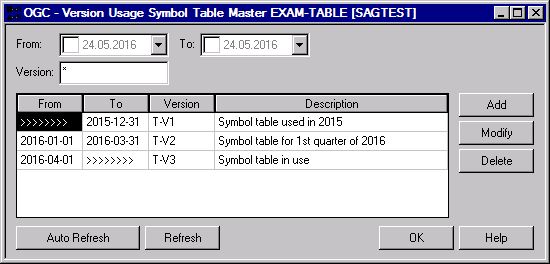
The window lists the version usage defined for the selected symbol table master version (the table is empty if no definition exists).
If you enter an asterisk (*) in the
Version field, all version usages defined for all versions
of the symbol table master are listed in the window as shown in the example
above. The fields and columns are explained in
Fields and Columns:
Version Usage Definition.
The following functions are available:
| Function | Description |
|---|---|
| Add | See To add or modify a version usage definition. |
| Modify | Modifies the usage definition selected in the table row. See To add or modify a version usage definition. |
| Delete | Deletes the usage definition
selected in the table row.
A window prompts you to confirm the deletion with Yes or cancel the action with No. |
| Auto Refresh/Refresh | See Refreshing Object Lists. |
 To add or
modify a version usage definition
To add or
modify a version usage definition
In the Version Usage Symbol Table Master window, choose Add to create a new definition.
Or:
In the Version Usage Symbol Table
Master window, select the table row that contains the
definition you want to modify, and choose .
The input fields that appear in the window are shown in the following example:
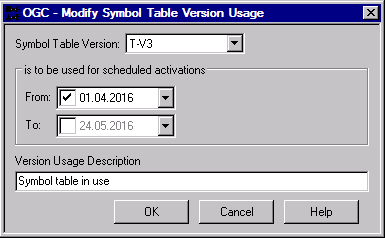
Enter the required values or select a value from the drop-down list boxes. Activate or deactivate a From or To field by selecting the check box next to it. Deactivated fields are ignored and not processed. For additional information, see Fields and Columns: Version Usage Definition.
Choose OK when you are finished.
| Field/Column | Description |
|---|---|
| From
(column or input field) |
Start date of a default usage period of
a network version.
Possible value for an input field: A start date or no value (check box of field not selected) for no start date. You can open the drop-down list box to select a date from a calendar. Default: start date is not defined. Note: |
| To
(column or input field) |
End date of a default usage period of a
network version.
Possible value for an input field: An end date or no date (check box of field not selected) for an unlimited (infinite) time. You can open the drop-down list box to select a date from a calendar. Note: Default: end date is not defined. |
| Version
(column) |
Symbol table version for which the usage is defined. |
| Description
(column) |
Description of the version usage. |
| Symbol Table Version | Input field for the symbol table
version to be used as the current version during the period specified in the
From/To fields.
Enter the required version or select a version from the drop-down list box. |
| Version Usage Description | Input field for a description of the
version usage.
Maximum input: 70 characters. |
 To save a master symbol table as a file
To save a master symbol table as a file
In the object workspace, select a Symbol Table Master instance and choose from the context menu.
Specify the file format and type as described in Report Output Options and choose .
An output file similar to the example below is created:
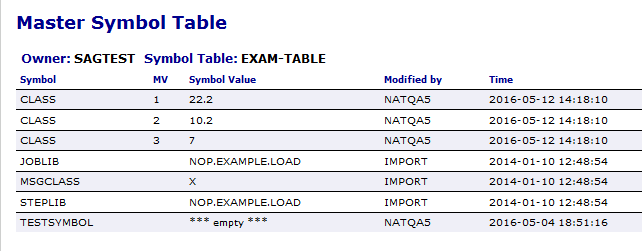
This output displays the selected symbol table master and all related information.
 To save an active symbol
table as a file
To save an active symbol
table as a file
In a Symbol Prompting window, select Save active symbol table as file and choose Continue.
Specify the file format and type as described in Report Output Options and choose .
An output file similar to the example below is created:

This output displays the active symbol table and all related information.
This section covers the following topics:
 To list all functions available for a symbol table active
node
To list all functions available for a symbol table active
node
In the object workspace, select a Symbol Table Active node and open the context menu.
The following functions are available:
| Function | Shortcut | Description |
|---|---|---|
| List | F8 | See Listing Objects. |
| Refresh | F5 | See Refreshing Object Lists. |
| Filter | F3 | See Filtering Objects. |
| Set Drag And Drop Function | --- | See Drag & Drop. |
 To list all functions available for a symbol table active
To list all functions available for a symbol table active
In the object workspace, select an instance of a Symbol Table Active node and open the context menu.
The following functions are available:
| Function | Shortcut | Description |
|---|---|---|
| Open | CTRL+O | See Modifying a Symbol Table Active. |
| Display | CTRL+D | See Displaying Objects. |
| Active Usage | --- | See Listing Active Jobs Using a Symbol Table Active. |
| Add to Workplan | --- | See Add to Workplan. |
| Save as File | --- | See Saving Symbol Tables as Files. |
 To modify an active symbol table
To modify an active symbol table
In the object workspace, select a Symbol Table Active instance.
Open the context menu and choose , or press CTRL+O.
A Maintenance Symbol Table Active window similar to the example below opens:
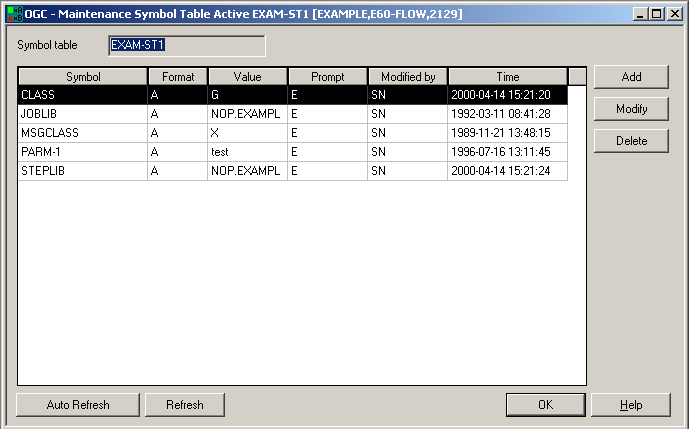
Here, you can add, modify or delete a symbol of the symbol table without affecting the master symbol table definition.
The fields, columns and functions available in the window correspond to the fields, columns and functions of the Maintenance Symbol Table Master window. They are explained in the following sections:
Make your definitions and choose OK when you are finished.
This function is used to display all active jobs using an active symbol table.
 To list all active jobs using an active symbol table
To list all active jobs using an active symbol table
In the object workspace, select a Symbol Table Active instance.
Open the context menu and choose .
An Active Usage Symbol Table Active window similar to the example below opens:
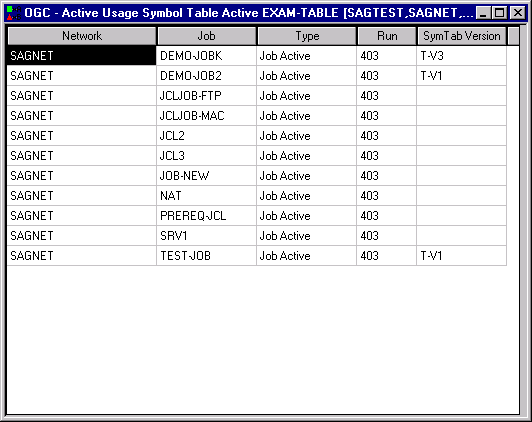
The window lists all active jobs used by the active symbol table. The columns contained in the window correspond to the columns in the Where used Symbol Table Master. They are explained in Columns: Symbol Table Usage
- Restrictions:
You cannot delete a master symbol table that is still used by one or more jobs. In this case, the error message
EOR1859 - Symbol Table ... used in Definitionsoccurs. You can only delete the symbol table if you either specify another symbol table for these jobs or delete them. Proceed as described in Listing Jobs and Networks that Use a Symbol Table Master to find the jobs that use the symbol table.You cannot delete a master symbol table with a symbol table version that is still defined in the version usage of the symbol table. In this case, the error message
EOR2691 - Version ... - current usage foundoccurs. You then need to delete the usage defined for the version as described in Maintaining the Usage of Symbol Table Versions.
 To delete a symbol table master
To delete a symbol table master
In the object workspace, select a Symbol Table Master instance.
Choose Delete from the context menu, or press DELETE.
A confirmation window opens.
Choose Yes to confirm the deletion or No to cancel the action.